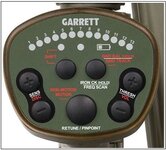John-Edmonton
Silver Member
- Mar 21, 2005
- 4,404
- 3,972
- Detector(s) used
- Garrett- Master Hunter CX,Infinium, 1350, 2500, ACE 150-water converted 250, GTA 500,1500 Scorpion, AT Pro

My first type of air test consisted of placing the target on the ground, with the shown settings of discrimination and threshold, with the discrimination setting set at zero. To maintain a certain level of reliability, I performed the test wearing sweat pants, T-Shirt, no rings, wallet, belt, watch with empty pockets and shoes with no metal. The measurements were taken from a static fixture, my leg, where the horizontal coil would barely yet audibly get a reading from the target lying horizontal on the ground, on an area free of any metal. I have fairly neutral ground, consisting of a humus layer in the upper stratus of about 3 inches, with clay below. The test was taken in my backyard, about 25 feet from my house. I had to deal with a large amount of EMI, having to retune the ATX at times to quiet it down. As previously mentioned, I measured the audio barely audible however still repeating against the still audible EMI. As predicted, the large gold ring managed to get the greatest depth. My understanding of the ATX platform is that it was specifically tweaked for gold. The other gold ring, considerably smaller in mass and diameter, also fared well. My favorite target for depth testing is a small lead 22 projectile, which came in at about 8 inches, with a sensitivity set at 6, possible max out at 13 and a threshold setting at 4 with a possible max also at 13. Running both these settings any higher just made the ATX too unstable at it's location. And, as a typical household, we own a couple large screen TV.s, cable, wi-fi for computer and cell phones.

This second test was was again performed in my back yard, only I moved the test away from the house another 10 feet. And again to maintain a certan level of reliability, I performed the test wearing sweat pants, T-Shirt, no rings, wallet, belt, empty pockets and shoes with no metal. What made this test different from the one above, is that instead of placing the target on the ground, I performed strictly an air test, measuring the distance between the coil and target, with no matrix past the coil except air. I was curious as to the amount of EMI present. As it turned out, the EMI was slightly less, however probably due to the air tests being performed further away from the source (house). One purpose of the test was to show the difference in depth with an increase of threshold on the ATX. The increase of threshold from eight to 10 while still maintaining a sensitivity of 8 showed about 1 inch increase with the large gold ring, 1 inch increase on the nickel and a doubling of depth on the small fleck of goldfrom 0.5" to 1". That fleck of gold is so tiny it won't read on my electronic weigh scale set in grams. I included a nickel in my air tests this time, as a nickel can be a good indicator for a piece of gold, and I also wanted to see how it would read, assuming that the ATX was tweaked for gold. The results are quite interesting, when comparing all the targets against each other.
Please remember......these are air tests, and your reading for depth in the ground will deviate from my results, based on ground conditions, water, moisture, target size, EMI, coil used, and how the machine is programmed. Air tests are useful for comparisons of settings against a target, and also comparisons against numerous targets, under different conditions.







